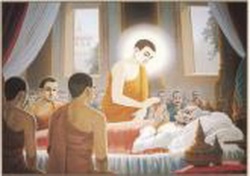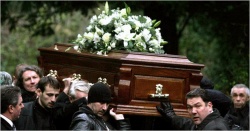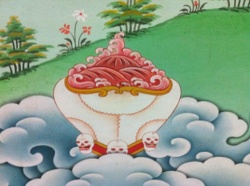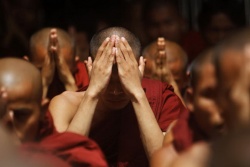Funeral (Buddhism)
In Buddhism, death marks the transition from this life to the next for the deceased.
Among Buddhists death is regarded as an occasion of major religious significance, both for the deceased and for the survivors. For the deceased it marks the moment when the transition begins to a new mode of existence within the round of rebirths. When death occurs, all the karmic forces that the dead person accumulated during the course of his or her lifetime become activated and determine the next rebirth. For the living, death is a powerful reminder of the Buddha's teaching on impermanence; it also provides an opportunity to assist the deceased person as he or she fares on to the new existence. BuddhaNet has published a guidance article about the subject, which also discusses the traditions of different Buddhist schools. There are also several academic reviews of this subject
For the non-Arahant, death is a time of transitioning to a yet another rebirth; thus, the living participate in acts that transfer merit to the departed, either providing for a more auspicious rebirth or for the relief of suffering in the departed's new existence. For the living, ceremonies marking another's death is a reminder of life's impermanence, a fundamental aspect of the Buddha's teaching. Death rites are generally the only life cycle ritual that Theravāda Buddhist monks get involved in and is therefore of great importance.
Customs in Sri Lanka
Offering of cloth on behalf of the dead (mataka-vastra-puja): Before a cremation, at the deceased's home or cemetery, the funeral's presiding monastics are offered a white cloth to be subsequently stitched into monastic robes. During this ceremony, the following verse which was, according to the Mahaparinibbana Sutta, spoken by god Sakka after the passing away of the Buddha, is recited:
Impermanent alas are formations,
subject to rise and fall.
Having arisen, they cease;
their subsiding is bliss. Aniccā vata saṅkhārā,
uppādavayadhammino.
Uppajjitvā nirujjhanti
tesaṃ vūpasamo sukho.
In addition, as relatives pour water from a vessel to an overflowing cup to symbolize the giving of merit to the deceased, the following verses are recited:
As water raining on a hill
flows down to the valley,
even so does what is given here
benefit the dead. Unname udakaṃ vaṭṭhaṃ yathā
ninnaṃ pavattati
evameva ito dinnaṃ
petānaṃ upakappati.
As rivers full of water
fill the ocean full,
even so does what is given here
benefit the dead. Yathā vārivahā pūrā
paripūrenti sāgaraṃ
Evameva ito dinnaṃ
petānaṃ upakappati.
Preaching for the benefit of the dead (mataka-bana): Within a week after the funeral (usually on the third day after), a monastic returns to the deceased's home to provide an appropriate hour-long sermon for surviving relatives and neighbors. The sermon is usually held on the sixth day after the death occurred and often family, friends and neighbours are treated to a meal afterwards.
Offering in the name of the dead (mataka-dana): Made three months after the funeral and then annually afterwards, the deceased's survivors hold an almsgiving on their behalf.
Mahayana traditions
See also: Japanese funeral and Buddhist chant
In China, numerous instructive and merit-transferring ceremonies are held during the forty-nine days between death and rebirth. For most Chinese funerals, the practice of recitation of the Amitabha Sutra and the name of Amitabha is an important part of the average Chinese funeral. Along with cultural practices, such as the burning of joss paper (which is discouraged by most practicing Buddhists), practitioners are often cremated.
Mummification
While mummification does occur as a funeral custom in a variety of Buddhist traditions, it is not a common practice; cremation is more common. Many Mahayana Buddhist monks noted in their last testaments a desire for their students to bury them sitting in a lotus posture, put into a vessel full of coal, wood, paper and/or lime and surrounded by bricks, and be exhumed after approximately three years. The preserved bodies would be painted with paints and sticked with gold. Many were so respected that they were preserved by their students. They were called "Corporeal Bodhisattvas", similar to that of the Roman Catholic incorruptibles. Many were destroyed during the cultural revolution in China, some were preserved, such as Huineng, the Sixth Patriarch of Ch'an Buddhism and Kim Kiaokak, a Korean Buddhist monk revered as a manifestation of Ksitigarbha, and some have been discovered recently: one such was the Venerable Tzu Hang in Taiwan; another was the Venerable Yuet Kai in Hong Kong.
Other notable examples of Buddhist mummification (Dashi-Dorzho Itigilov in Siberia, Loung Pordaeng in Thailand, and a 15th-century Tibetan monk from Northern India examined by Victor Mair in the documentary The Mystery of the Tibetan Mummy. While the documentary suggests that the monk may have consumed poisonous matters on purpose, there is no proof of such practice for any of the mentioned persons, so the poisonous substances occasionally found in their remains may have been applied to their corpses by their followers.
Tibetan traditions
A person who is dying and who is recently dead will have for example the Tibetan Book of the Dead read to them (in the Nyingma tradition) to help guide them through the transition period (Tib.: bardo) between lives, easing attachments to this life and deepening bodhisattva wisdom. The corpse is either cremated or dismembered and fed to vultures (Tib.: jhator).
Other Tibetan traditions have other special texts read and rituals performed, which may also be personalized to the specific (vajrayana) practice a person focused on during his/her life. As the bardo is generally said to last a maximum of 49 days, these rituals usually last 49 days.
Death and dying is an important subject in Tibetan Buddhism as it is a most critical period for deciding which karma will ripen to lead one to the next rebirth, so a proper control of the mind at the death process is considered essential.
After prolonged meditation, the meditator continues into the bardo or even towards enlightenment. Great masters are often cremated, and their ashes stored as relics in stupas.
In Tibet, firewood was scarce, and the ground often not suitable for burial, so the unusual practice of feeding the body to vultures or other animals developed. Known in Tibetan as jhator and literally translated as "Alms to the Birds", this practice is known as Sky burial. One can see this also as an offering to these animals, a last act of generosity and detachment to one's own body.





